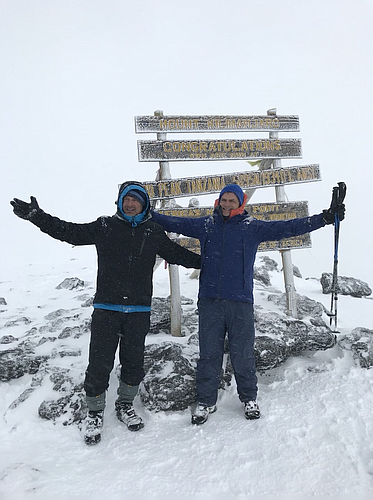- January 11, 2025
-
-
Loading

Loading

Lightning cuts through the blizzard’s snowy haze in a blinding flash, so close it makes some people’s hair stand on end. Wind howls around the mountain, making it hard to hear anything or anyone else. The icy air cuts through layers of clothing with each blast.
The idea of taking on Mount Kilimanjaro had been several years in the making for Matt Durfee and Anthony Lightman. It all started in 2010, after the duo spent a week hiking along Hadrian’s Wall in Great Britain.
“Hadrian’s Wall was really high on my bucket list for a really long time,” Durfee said. “To go out there and be among the ruins was just appealing to me.”
After completing that hike, the two quipped about what their next adventure would be — and that’s when Mount Kilimanjaro was first mentioned.
But it wasn’t until this year that Durfee, a Bay Hill resident, and Lightman, a Windermere resident, decided to take on the challenge of hiking the Tanzanian beast.
The climb was scheduled for late April. To prepare, both men spend several months at the gym working on their core and legs. They knew the hike up would be hard, but they never anticipated just how challenging it would be.
“It was way more than we expected,” Lightman said.
Durfee still remembers the moment he looked out of his hotel window and saw Mount Kilimanjaro towering in the distance.
“I thought, ‘Oh my God, what have I gotten myself into,’” he said.
Mount Kilimanjaro is the highest mountain in Africa, rising to an elevation of 19,341 feet. Every year, more than 20,000 people attempt to reach the summit, but thousands are forced to end their climb early because of altitude sickness.
And every year, the mountain claims an estimated 10 lives. Most recently, it took the life of a 35-year-old Irish woman on Friday, July 14.
ONE FOOT IN FRONT OF THE OTHER
Sleep never came during the brief stop at base camp thanks to a combination of adrenaline and excitement. At midnight, the group began the final climb to the summit. But that was hours ago, and now exhaustion sets in. Putting one foot in front of the other takes every last ounce of concentration and effort. It’s a vertical climb in darkness and snow.
Durfee and Lightman chose to climb the Machame route up the mountain, which is one of the most popular routes among tourists. They climbed with a group of 10 others — all strangers — but Durfee and Lightman were the oldest by more than 30 years.
“We held our own,” Durfee said.
But one of their biggest concerns was altitude sickness.
“You cannot prepare for the altitude,” Durfee said. “Nobody knew what to expect.”
For Lightman, the altitude proved to be a non-issue, but Durfee lost his appetite for part of the climb and could only stomach the Snickers bars he had packed.
As the group reached higher elevations each day, the climate changed from tropical rainforest to moorlands to desert.
“It went from 100 degrees to minus 20,” Lightman said.
And the higher the group got, the steeper the climb became.
“You had to watch every step you took, because if you twisted your ankle, you were done,” Lightman said. “It was mentally challenging as well as physically challenging.”
The guides seemed to follow an unmarked trail up vertical cliffs and around boulders. They instructed Lightman and Durfee where to place their hands and feet as they climbed up steep rocky paths.
“A lot of the times it was head down, step by step,” Durfee said.
Every few hours, the group stopped for a water break. They were all required to drink three liters of water every day. And every night, the guides checked everyone’s oxygen levels and heart rate.
‘IT FELT LIKE AN EPIPHANY’
The swirling snow makes it hard to see the group as they hike up the mountainside. Even the light of everyone’s headlamps is dimmed in the storm. The trail is long gone under the snowdrifts. The only trail left is the footprints each person leaves behind.
After four full days of climbing, the group reached base camp, where they had dinner and were told to try and sleep for a few hours before the midnight climb up to the summit.
The final hike took seven-and-one-half hours, climbing straight through a thundering blizzard. Durfee said he realized they had climbed into the storm cloud when lightning began striking the mountaintop horizontally.
During the final climb, Lightman’s hands started going numb and losing function. His gloves had taken on too much snowmelt. Worried about frostbite, one of the guides opened his own jacket so Lightman could warm his hands against his body.
After hours of exhausting climbing, they reached Uhuru Peak.
“It was the biggest sense of accomplishment of my life,” Lightman said. “I couldn’t believe it. I didn’t think I had it in me to do something that challenging. It felt like an epiphany.”
It was at that point that Durfee opened up his coat to reveal a black-and-white necktie buried under seven layers of clothing. It was his father’s tie. He had worn it up the mountain in honor of his father who had died recently.
After a moment of reveling in his accomplishment of reaching the top of the mountain, Durfee stepped away from the group.
“I got a little emotional,” he said.
But the hiking wasn’t over. It took another two days to get down the mountain. By then, they were completely exhausted. To recover from their grueling hike up Kilimanjaro, they spent several days on a safari.
“After Kilimanjaro, it was a way to relax for us,” Lightman said.
Hot water gushes from the shower head. After going a week without showering, the steady stream of water feels like heaven. And soap never smelled so good.
Contact Brittany Gaines at [email protected].